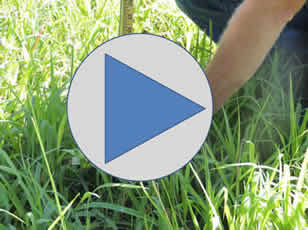- Forage Species
- Forage Management
- Publications
- Forage Focus
- Related Links
- Variety Testing
- Frequently Asked Questions
- Alabama Forages Home
- ACES Livestock & Poultry
Using a Grazing Stick for Pasture Evaluation
A grazing stick can be used to obtain an estimate of available forage dry matter in the field.
This guide addresses the steps in using a grazing stick:
Step 1: Site selection
Walk across pasture in a diagonal. Every 10-20 steps, stop and take a height measurement (see Step 2).
Step 2: Taking a height measurement
To take a height measurement, place the stick upright at the bottom of the plant canopy. Place your hand against the stick where the top of the plant canopy and the height marking on the stick meet. Record your estimation. Repeat across multiple locations in field.
Step 3: Average
Take the average of the number of height measurements collected to get a representative height for the pasture. This height will represent the begin grazing height.
Step 4: Calculate
Use the “Forage Available per Acre Inch” table on your stick to estimate available forage dry matter per acre inch using the following equation:
Begin grazing height _____ inches - End grazing height _____ inches = _____ inches
The “begin grazing height” is the height measurement taken in the field. End grazing height is the height at which animals will be removed from the pasture (found on grazing stick).
Multiply the difference by the pounds of dry matter/acre/inch. This will vary depending on stand density:

Example. Annual ryegrass, fair to good stand
Begin height, 10 inches
End height, 3 inches
10 inches – 3 inches = 7 inches of available forage dry matter
7 inches x 250 lb dry matter/acre/inch = 1,750 lb dry matter/acre
Prepared by Jennifer Johnson, Ph,D,Extension Forage Specialist, and
Kim Mullenix, Ph.D, Extension Beef Cattle Systems Specialist,
Auburn University, Auburn, AL. Series: FF-1

 Menu
Menu



